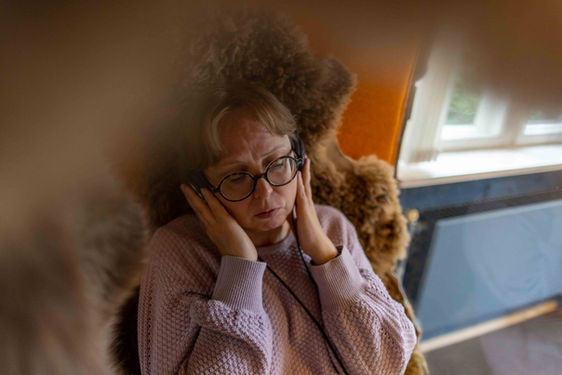The Wolf’s Den (an introduction on how to build Rome in a few meetings)
Saara-Maria Kariranti,Mustarinda
photo: Ingvill Sunnby

A multi-channel sound installation with fur in the hallway of the Tinn municipal council and in the Rjukan Library.
Humans can solve even the most challenging problems, but not alone. Together, society will be able to adapt its ways of using resources and energy to face our unknown future.
In Tinn's public library, an art installation is using the sound of wolves as material of the installation. Wolves are a provocative and controversial topic wherever they appear but the goal is not to take a stand for or against the wolf. The goal is much broader and points to something deeper than the wolf debate, which is not even a real issue in Rjukan. Rather, it's an example of topics which polarize and split people and politicians all across the European continent.
Party politics can be beneficial to democracy, but it can also lead to situations where discussions become polarized and stagnate the public discourse by only presenting the image and ideology of each respective party, by building trenches and not being willing to find common ground.
According to political science professor Henri Vogt from the Turku university, the decision-making structure of a representative democracy would need genuine mutual discussion, so that political decision-making is capable of far-reaching solutions as is required by the prevailing global political and ecological situation.
(Podcast, Vogt, 2014)
“The legitimacy of deliberative decision-making is not sought from the will of the majority, but from the justification tested by the discussion of the grounds of the decision.” (Pekonen, 2011). - The exhibition format used in my research aims at this opening of a deliberative discussion between the representatives.
The wolf is seen as a controversial representative of wilderness. Some of us take the position of protector of children and domesticated animals from wolves and others have taken the position of protector of wolves. In the artwork, in its imaginary reality, I am able to place the wolf in the position of our protector, caretaker and nurturer.
Which is not so uncommon in our rich folklore tradition that has many stories of human children raised by animals. Like ‘Romulus and Remus’, ‘The Children of Mars’ and ‘The Virgin of Vesta’ were all raised by a wolf. Romulus and Remus are actually the founders of Rome in this widespread tale.
The installation will be part of my PhD research for the University of Lapland. In this “Political Conversation Through Aesthetics – sensory based intervention in political decision-making processes'', research asks how and under what conditions art becomes part of the political decision-making process by presenting contemporary artworks prior to decision-making. Exhibitions included in the study has been organized and shown before the meetings of the Inkoo municipal council during the spring of 2022. The researcher participated in the exhibitions as an artist, curator and producer.
Aesthetics, in this sense is not as much like in its everyday-use, in terms of meaning something beautiful, but rather in this case, closer to its original meaning; Aesthetics as part of academic discourse — like what’s possible to sense and sense-based knowledge. The body and its senses, human emotion and the perceptional ground of our intellectual processes, is not very visible in political rhetoric or in the architecture made around contemporary decision making. All the important spaces surrounding modern decision making is built for particular systems of communication and meantfor human actors who move information through specific language or numbers. Often reserved for initiates of particular disciplines. In my research, art is not for illustrating science, having ready-made instant solutions or conveying messages in esoteric jargon to academic colleagues. Art is for connecting information and theoretical understanding to our bodies and emotions. For awakening and deepening our collective knowledge and wisdom, to which we are all fundamentally connected.
Saara-Maria Kariranta (born 1974 Tuusula,Finland) is an Inkoo based Finnish artist, who combines sculpture techniques with everyday objects and new technologies. In recent years, her installations have focused on the practices of western post-capitalist societies. She often collaborates with Jarmo Ilmari Somppi. Together they create multi-sensory, charged spaces, where the boundaries of the inanimate and the living, as well as the mental and the material, are blurred. She has participated in exhibitions in Finland and abroad. For example Helsinki Art Hall, Mänttä Art Week, Wäinö Aaltonen Museum, Pori Art Museum and Art Museum Sinkka, Kerava. She was awarded the Environmental Work of the Year award in 2013 (together with P. Niittyvirta). She graduated from the Academy of Fine Arts with an MA in 2012 and started her doctoral studies in 2022 at the University of Lapland.
Saara-Maria is participating as a representative of the Mustarinda Association, a collaborator of the Rjukan Solarpunk Academy. The Mustarinda Association is a group of artists and researchers, whose goal is to promote the ecological rebuilding of society, the diversity of culture and nature, and the connection between art and science. At the centre of their activity lies contemporary art, boundary-crossing research, practical experimentation, communication, education and events. The Mustarinda Association reaches towards a post-fossil culture by combining scientific knowledge and experiential artistic activity. The Mustarinda Association is active both internationally and locally. Their activities are rooted at the Mustarinda house at the edge of the Paljakka nature reserve in Kainuu; the house has versatile spaces for artist and researcher residencies, as well as hosting various exhibitions and events.












